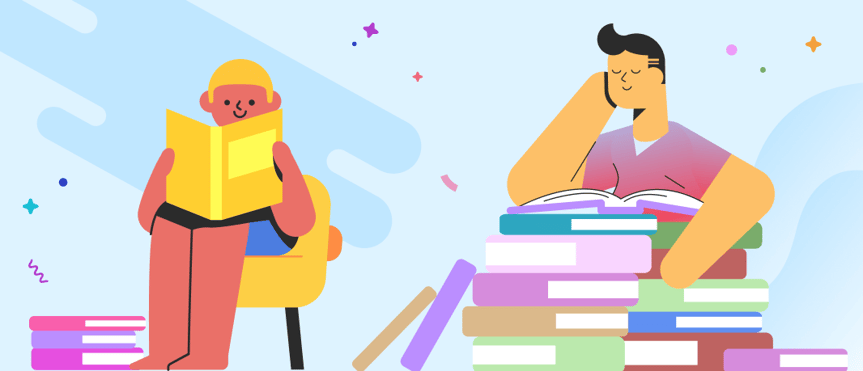Motivating students to read can be a challenge for parents and teachers alike, especially today. The ubiquitousness of digital media, from social media to video games, can drastically diminish the desire to pick up a book. Even us adults can relate to that! However, psychology and gamification research offer useful insights and strategies to encourage students to develop a love of reading and increase student motivation.
In this blog, we will explore how educators can use data-driven insights about human psychology to nurture positive relationships with reading. We’ll give a brief primer on the different types of motivation and what gamification is, including how we incorporate gamification elements and research into Beanstack. Then, we’ll delve into suggestions for incorporating reading rewards that promote an intrinsic motivation to read. Finally, we’ll discuss strategies for understanding and dealing with a lack of reading motivation in students. With these tools, we hope to empower more teachers and caregivers to help students discover a love of reading.
Understanding Motivation and Gamification
Self-determination theory (SDT) is a psychological framework for studying the interconnectedness of human motivation, personality, and our shared psychological needs. Motivation, or the reasons fueling a person’s actions and behaviors, is commonly thought of as being either intrinsic or extrinsic. In SDT, an individual’s autonomy, or free will, is the main difference between extrinsic and intrinsic behavior. Researchers and psychologists often place the two types of motivation on two ends of a continuum, with extrinsic motivation aligned with more controlling external actions, like directives (homework assignments, for example) or pressures (including from peers and parents). Intrinsic motivation corresponds with actions that an individual takes willingly and for sheer enjoyment of them. For instance, an example of intrinsic reading motivation would be choosing to read during free time.
Researchers have consistently found that the self-determination aspect behind intrinsic motivation leads to more positive academic and emotional development. Studies also show that extrinsic motivation can be effective in the short term, but has the potential to undermine intrinsic motivation in the long term—and that extrinsic motivation doesn’t typically transform into intrinsic motivation, even when it’s closest to the intrinsic side of the motivation spectrum and integrated into a person’s goals and values.
However there are ways to foster situations that promote intrinsic motivation over extrinsic motivation. According to motivational psychologists, all individuals, regardless of age, are more likely to experience intrinsic motivation when their basic psychological needs are met. Those needs are autonomy (control over your own decisions), competence (feeling capable and effective), and relatedness (being connected to and cared for by others). These innate human desires to be self-guided, appropriately challenged, and connected are at work in all situations—and especially in education.
That’s where gamification comes in. Gamification takes the engaging and self-motivating elements of games (analog or digital!) and applies them to non-game contexts, such as education. At its best, gamification can increase motivation by tapping into intrinsic human desires—those same human desires for autonomy, competence, and relatedness that SDT psychologists uphold for the development of intrinsic motivation. When it does so, gamification makes learning more engaging and fun, leading to increased motivation, better learning outcomes, and higher academic achievement. In the context of reading, gamification makes a significant difference when it comes to reading comprehension and overall reading skills.
We use gamification principles throughout the Beanstack user experience. Our platform awards badges to encourage students to read (no matter what reading material they choose) and allows administrators to add rewards for completing reading challenges or reaching key milestones. We also foster connections among students and communities, who can share what they’re reading with others and reflect on their reading by writing reviews.
The Right Rewards
Rewards are a common motivational tool, both in education and the wider world. Whether racking up gas points while shopping or choosing to do an extra credit assignment, the promise of a reward can help stop, shift, or spur on specific behaviors. When it comes to motivating students to read, however, some types of rewards are better than others.
Small Rewards
Small rewards, like buttons or pencils, can have a big impact on students' reading motivation. They can be an excellent (and affordable) way to nurture relationships with students and help them form positive associations with reading. Some librarians stock a treasure chest of fun trinkets and tokens for kids to pick from. We’ve even heard of one media specialist who prints stickers to match the badges their students earn!
Surprise Rewards
When winning something is a surprise reward for reading, students get an unexpected boost—almost like giddiness—tied to their reading behaviors. Rewards like unanticipated treats or recognition in class increase students’ feelings of competence and relatedness. Initiatives like Atlanta Public Schools’ “Prize Patrol," where school or district leaders visit individual classrooms to surprise top readers with prize packs, give kids a big reading boost. So do mystery prizes at different milestones in a reading challenge.
Public Praise and Recognition
Recognition and positive, constructive feedback are two ways to incorporate what SDT researchers call “non-controlling rewards.” These are rewards that can reinforce a student’s internal motivation and boost their confidence when the student doesn’t see them as controlling. They uphold the independent choice behind the student’s reading. Public recognition can range from weekly all-school announcements or newsletter blurbs that recognize top readers to classroom leaderboards.
Books
Rewarding reading with the tools to continue reading is a great motivational tactic. Even when a book reward is given for meeting a certain reading goal, like challenge completion or reading for 5 hours, it can help convey the value of reading to students. Letting kids pick the book they win is a great way to reinforce their autonomy and encourage self-motivated reading.
Combatting a Lack of Motivation
Understanding and dealing with a lack of motivation, often called amotivation, is also an important aspect of motivating students to read. Amotivation is often caused by the absence of those three basic human needs, resulting in feeling a lack of competence, a lack of interest or relevance, and resistance to influence. Once you identify the root cause behind a student’s lack of motivation to read, you can employ targeted strategies to help them recapture their motivation.
Build Confidence With Attainable Goals
When a student experiences repeated failures or negative experiences, they may develop learned helplessness and stop trying to succeed. Many reluctant readers experience this type of amotivation in quiz-based reading tools like Accelerated Reader, after failing reading comprehension skills tests over and over again. And who can blame them? It’s incredibly demotivating to feel like you’re continually missing the mark. To reverse this, provide achievable goals and tasks that gradually increase in difficulty, allowing students to experience success and build their confidence. Positive and constructive feedback can also help to reinforce their sense of competence and have a positive effect on reading habits for children of all grade levels, including elementary school, middle school, and high school.
In reading challenges, for instance, badges set at small, attainable amounts of reading, like 10 or 20 minutes, help students find success and feed their confidence. Promoting reading time instead of pages read or book points earned is another crucial step to reshaping students’ self-view and creating confident readers. Providing small rewards and recognition as they build up to larger reading goals will keep them on track when it comes to reading achievement and academic performance.
Provide Diverse Reading Options
Students can feel a lack of interest, relevance, or value when they perceive a disconnect between reading and their interests or goals. They may not see how their wide-ranging curiosities and interest areas, whether they be sports, fashion, or video games, align with reading—especially in quiz-based applications that lock students into set reading choices at their current reading level.
To overcome this type of amotivation, offer a variety of reading materials and reading types to students and allow them to choose what books they find appealing. Different students are naturally drawn to large format books, audiobooks, chapter books, or graphic novels, just like they’re interested in different topics and genres. You can also link reading to real-world experiences or events happening in your community to increase reading’s relevance and value to students.
Embrace Student Independence and Autonomy
A student may demonstrate resistance to influence or authority to preserve their sense of independence and peer standing or relatedness. In a reading context, these behaviors can be challenging to overcome, and can even influence other students’ motivation. To address this motivational black hole, try to foster a sense of autonomy and control within the classroom.
You can start small with minor classroom decisions, like allowing students to bring in or pick out a book of their choice to read in pairs during class and work your way up to student-led activities. Focusing on positive relationships with students can also help create a sense of relatedness that encourages students to engage in activities they might otherwise resist.
Bring These Strategies Into Your Classroom
There is no single solution for motivating students to read. Kids and their interests, motivations, and psychological states are a hodgepodge of diversity. But by understanding gamification and the psychology of motivation, you can create a welcoming and nurturing reading environment. By using the right kinds of rewards and motivational strategies, you’ll create a classroom culture that promotes a love of reading and lays the groundwork for a lifetime of self-guided reading motivation.
We’re here every step of the way to help you activate and encourage your students’ love of reading and drive student achievement. Contact our team to request a demo and see how Beanstack can support your district-wide goals this school year.


